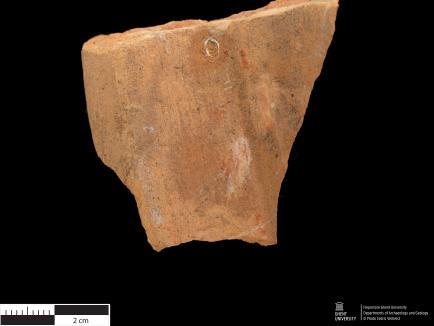Post Medieval - Red oxidized ware (7.RO.BE.0003)
Hand specimen pictures (macro & binocular)
Thin section pictures
Find location
- Category
- Red oxidized ware (Post Medieval)
- Fabric name
- Chronology
- Post Medieval > Contemporary > 19th century
- Dating method(-s)
- /
- Potters' mark
- No
- Additional information
- rim fragment of a flowerpot (?)
Find location
- Site type
- Pottery production
- Location
- Belgium; West-Vlaanderen; Brugge
- Site name
- Brugge, Sint-Maartensbilk - Zwijnstraat
- Excavation or Survey Team
- Stedelijke Archeologische Dienst Brugge
- Additional contextual information
- site code BR83/STM; archaeological site monitoring; kiln and potter's waste; identified as the "Paresys" (or Parisis) workshop
- Slip
- No
- Slip color
- Glaze
- No
- Glaze type
- Glaze color
- Glaze additives
- Additional information
- Slip
- No
- Slip color
- Glaze
- No
- Glaze type
- Glaze color
- Glaze additives
- Additional information
- Surface color
- orange
- Surface texture
- Rough
- Fracture color
- orange
- Inclusions (non-plastics/tempering)
- quartz; red oval inclusions (clay pellet ?)
- Matrix and voids
- many vesicles
- Diagnostic features
- Additional information
- sample BR_PAR_ST1
- Flepostore inventory nr.
- ARCH1.L1.B25
- Original inventory nr.
- A0041
- Collection
- Archaeological Department, Ghent University
- Type
- Covered thin section
- Comparable thin section(s)
- Matrix
-
Oxidised orange-red fabric; brown (PPL), dark brown (XP).
Semi-homogenous matrix, non-calcerous with low optical activity.
- ca. 30-45% - Inclusions
-
Quartz (++; mono+, poly-, weathering and alteration), sedimentary rock detritus (+; quartz arenite, weathering and alteration), chert/flint (+), metamorphic rock detritus (+; low grade, weathering and alteration), possible igneous rock (--; granite), feldspars (-; plagioclase, microcline, weathering and alteration), muscovite mica (+-; el & eq), amphibole/pyroxene (--), O/Fe (+), clay pellets (+; iron-rich).
The coarse fraction consists of medium sand, the fine fraction consists of very fine to fine sand. Grains are generally rounded to subangular. Overall the fabric is moderately to well sorted and moderately to well orientated, close to single spaced.
- ca. 40-50% - Voids
-
Many vughs of various sizes, very well aligned, calcite infill.
- ca. 15-20% - Diagnostic features
- The fabric is characterized by a semi-homogenous oxidised matrix with low optical activity and high porosity. Dominant quartz inclusions with frequent sedimentary and metamorphic rock detritus, chert/flint, opaques/iron oxides and iron-rich clay pellets, common muscovite mica, few feldspars, and rare amphibole/pyroxene and possible granite fragment. Overall moderately well sorted fabric.
- Additional information
- Sample type
- Pottery
- Inventory number
- 7.RO.BE.0003
- Collection
- Archaeological Department, Ghent University
- Donating institute/person
- Raakvlak, Onroerenderfgoeddepot De Pakhuizen
- Host collection
- Raakvlak, Onroerenderfgoeddepot De Pakhuizen
- Other samples available
- Yes
- Sample collection method
- Archaeological Excavation
Cite this page as: Flepostore - https://flepostore.ugent.be/ceramics/7-ro-be-0003
Last modified: 2024-04-26.






